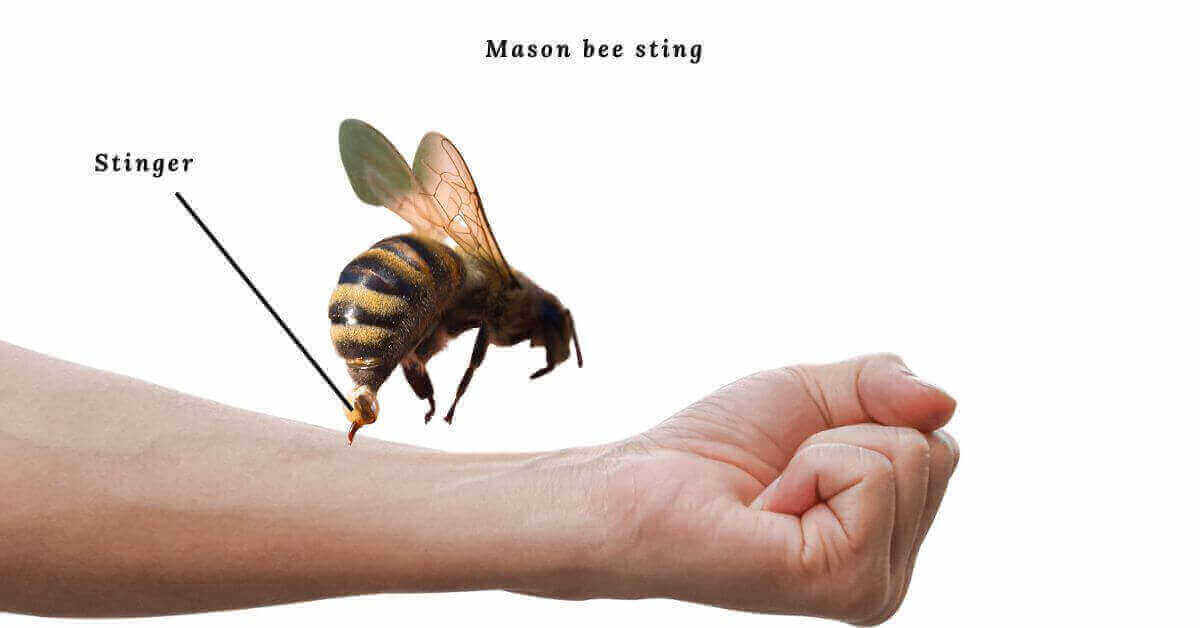The stinger is a bee weapon that bees use when they feel scared or unsafe. Usually, every kind of bee uses a stinger for fear of time. Some bees sting once in a lifetime, and some sting many times. Mason bees sting differently than other bees. Most bees sting once in their lifetime, like honey bees. Some bee stings are more likely to affect people with allergies.
Is it a real mason bee sting?
Mason bees are known by the name of solitary bees. These bees live alone and pay no attention to other bees are humans. So it means his chance of stinging is less than other bees. Yes, mason bees sting.
Mason bees are not dangerous for humans like wasps and other bees. Mason bees do not give any attention to humans. They can sting one in his life span. Like wasps, mason bees are not too aggressive. Female bees show aggression when they feel fear or danger.
Mason bees are the only bees that live without a queen, and none lead mason bees, so male mason bees are not aggressive. If female bees are laying eggs, they don’t use their stinger, but for the protection of their larva, she uses a stinger.
Unlike honey bees, mason bees sting 50% less. Queen honey bees sting for the protection of honey and young. That’s why honey bees are more stingy than mason bees.
What is a bee sting?
It is a process that bees use to inject their stinger into the body of others. When a bee stings, it produces toxic proteins that affect the immune system of the body that the bee stings. The sting causes the skin to swell.
What is a bee stinger?
It is a natural defense mechanism in bees that is present at the end of the bee’s body. Female bees have a stinger and use it to protect their eggs. Male bees are stingless. Female mason bees sting once in a lifetime.
How to remove a bee stinger?
When bees sting, they put their stinger in your skin. Sometimes the stinger goes deep into the skin, which is not easy to remove. If a bee stings on your skin. Try to remove the bee stinger by using your fingernails. Use ice against swelling. If you try to remove the stinger from something else that hasn’t been washed with Dettol, it releases the venom, which can lead to infection.

How to treat a bee sting?
If a bee stinger affects your skin, treat them using these steps.
| 1 | First, use Dettol or soap to wash the affected area and protect the area from the poison. |
| 2 | Use a wet, cold piece of cloth on the swelling area to reduce swelling. |
| 3 | See a specialist for treatment on the off chance that the contamination declines or gains out of influence. |
How long is the chance of an allergy with bee sting?
Bee sting swelling time.
Bee stingers feel pain for 2 to 3 hours, and the chance of increased infection is 48 hours less. In 7 to 8 days, the swelling subsides.
How do we treat mason bee stings?
The sting of mason bees does not have much effect on a human’s body, but this sting causes swelling. If mason bees sting, use calamine lotion and ice, which help you to avoid pain and swelling.
How do we attract mason bees?
Mason bees are social insects that are found in gardens or where fruits and flowers are present. If you want to attract mason bees, you can do it in the spring season because these bees like fruits and flowers, and spring is the season for them. Grow your garden with flowers; many bees grow flowers in your garden to attract mason bees, and many bee species can visit your garden in a day.
Where do we find mason bees?
Mason bees do not live in hives; they live in tree holes or underground. You may find mason bees in your garden or plants.
How do mason bees damage plants?
Mason bees are solitary species of bees, and that’s why every female mason bee creates their own nest for laying eggs. As a pollinator mason bees are important pollinators, but they damage plants. Mason bees cut the leaves of planets and plants die. It affects plant reproduction and causes less growth in plants.
Related Articles:
- Bees in Roof. How to Protect Roof from Bees?
- Life of Bees in Winter.
- How To Get Rid of Bees Natural Ways.
How to control mason bees? How to make mason bees go away?
If mason bees are in your garden and cut your flowers, use sprays on flowers or talk with bee specialists to solve this problem. Mason bees create holes in wood; if mason bees live in your house and build a nest in your door or window, spray or smoke by using these things mason bees live from the house.
10 Interesting Facts about Mason bees
| 1 | All mason bees live alone. |
| 2 | Mason bees have no queen bees which protect their hives. |
| 3 | These solitary bees do not build their combined nest. |
| 4 | Male mason bees do not mate with female worker bees. |
| 5 | Male mason bees do not mate with female worker bees. |
| 6 | Mason bees’ sting is less impacted than different honey bees. |
| 7 | The Pollination of mason bees is best like honey bees. That’s why they are the best pollinator. |
| 8 | It is dangerous for planets in the matter of reproduction. |
| 9 | Mason bees do not make honey. |
| 10 | Male mason bees are smaller in size than female bees. |
Mason bees are native bees of most Asian and European countries. and the osmia family of mason bees has 300 species, of which 125 species are North American native bees. The mason bees which are common in America are blueberry bees and blue orchid bees. The other two mason bee species found in America are horned face bees and Taurus bees, both native bees of Asia.
Mason bees vs Honey bees
Honey bees and mason bees are different in nesting habits, honey making process and sting habits.Honey bees make honey which mason bees cannot. Mason bees pollinate nectars for feed but they don’t collect nectars for making honey. Honey bees are more aggressive than mason bees. Mason bees cannot make colonies.
Do mason bees make honey?
No, Mason bees do not collect nectar; they collect pollen. Honey bees collect pollen and nectar both. Nectars are important for honey, which mason bees cannot collect, so mason bees cannot make honey. According to bee experts, mason bees are the best pollinator than honey-making bees.
Summary
25000 bee species are found worldwide; they all are not stingy. Most honey-making bees are stingy and more aggressive than stingless bees. Mason bees sting, which is less painful. The stinger of mason bees are treated easily. Mason bees are the native bees of America and Asia. My aim is to provide information about bees so that everyone loves nature.




